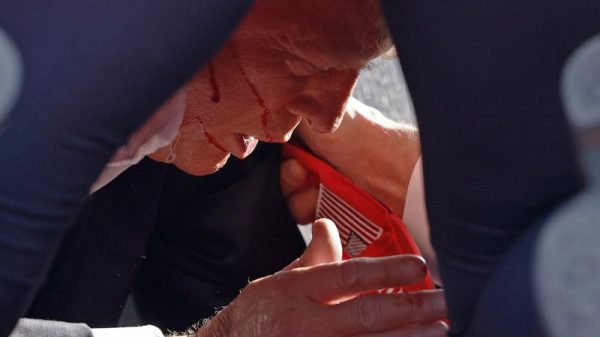An enormous sea snake from Norse legend that was fathered by the trickster god Loki and grew big enough to circle the globe is now the namesake for a different type of “monster” — a newly discovered species of a massive, meat-eating marine reptile known as a mosasaur, which lived about 80 million years ago.
Paleontologists recently described the previously unknown mosasaur from fossils found near the North Dakota town of Walhalla. The town’s name comes from Valhalla, the feasting hall of Norse mythology where dead heroes gather, so the scientists dubbed the mosasaur Jormungandr walhallaensis. Its name references Norse myths of Jǫrmungandr, the Midgard Serpent, as well as the site of the fossil’s discovery, the researchers reported Monday in the journal Bulletin of the American Museum of Natural History.
The fossil itself has a somewhat less poetic name: NDGS 10838. It includes a near-complete skull with a bony ridge over the eyes as well as jaws and some skeletal parts, including 11 ribs and 12 vertebrae. In life, the animal would have measured about 24 feet (7.3 meters) long and had a long face slimmer than those of its mosasaur cousins, said lead study author Amelia Zietlow, a paleontologist and doctoral candidate at the American Museum of Natural History’s Richard Gilder Graduate School in New York City.
Yet in other ways, the animal was one of a kind. A mix of features in the bones of its skull made it unexpectedly challenging for the scientists to classify the newcomer and hinted that the mosasaur group includes more diverse forms than expected, the study authors reported.
An unusual specimen
The fossil was collected in 2015 by the North Dakota Geological Survey, a state agency dedicated to geology and public education about minerals and fossils. In fact, Zietlow said, NDGS 10838 was discovered in a hillside by someone who had participated in one of the agency’s programs, and who was therefore able to recognize the object as a fossil and knew to alert agency officials.
When the scientists examined the skull, they quickly realized they had something unusual on their hands. Its ear bones, which were somewhat rectangular, resembled those of Mosasaurus, the genus of mosasaur giants. But the shape and high number of its teeth were a closer match to a genus of smaller mosasaurs: Clidastes. Meanwhile, the angle and number of teeth on a bony palate at the roof of its mouth were unlike anything seen in either of those two mosasaur groups.
“He’s got features that look in some ways like Mosasaurus, in some ways like Clidastes. And then in other ways, they’re completely unique to this individual,” Zietlow said. This combination of traits convinced the researchers that what they were looking at was a new genus and species.
However, fossilization often distorts bone, and it’s possible that oddities in the fossil were shaped by natural processes after the animal’s death, said paleontologist Takuya Konishi, an associate professor in the department of biological sciences at the University of Cincinnati. (The authors acknowledged this possibility; their study includes idealized illustrations of the intact skull showing what it may have looked like before it fossilized.)
When the researchers analyzed the data, their evolutionary tree showed an outcome called a polytomy — “when a bunch of different species kind of blur together into a single spot” — with Jormungandr walhallaensis and Clidastes, Zietlow said. “They’re closer to each other than they are to anything else. But within that group of things, it’s not quite sure how they’re related.”
Additional fossils of the newfound species could help fine-tune Jormungandr walhallaensis’ position on the mosasaur family tree, said Konishi, who studies mosasaur evolution and was not involved in the study.
Other unusual details in the fossil are punctures and scratches scarring the vertebrae; the researchers identified these as bite marks. The marks do not appear to have healed, suggesting that they happened toward the end of the animal’s life or were the work of a scavenger that ripped the mosasaur apart after it was dead.
“This might be why we don’t have the rest of the skeleton,” Zietlow said.
Further questions about what made the marks — and whether it was an attack that Jormungandr walhallaensis survived — will be addressed in future research by study coauthor Clint Boyd, a senior paleontologist with the North Dakota Geological Survey and a curator of the North Dakota State Fossil Collection, Zietlow said.
Mosasaurs and evolutionary enigmas
Mosasaurs were a diverse group of apex predators that swam the world’s oceans during the latter part of the Cretaceous Period, about 98 million to 66 million years ago. They lived alongside dinosaurs but are more closely related to modern lizards and snakes.
Some mosasaurs measured just a few feet long, while the largest — in the genus Mosasaurus — was nearly 60 feet (18.2 meters) long, and while mosasaur fossils are relatively plentiful, scientists “have just only scratched the surface of the ‘true’ mosasaur diversity,” Konishi said. New mosasaur specimens, such as NDGS 10838, help experts to unravel “the rich evolutionary history of these rather charismatic apex predators of the Cretaceous seas,” he said.
To that end, the new study makes a significant contribution by supplying “rich anatomical detail documented by a very able mosasaur worker, Ms. Zietlow,” he added.
“The authors clearly provided a very thorough and careful osteological description of the new specimen,” creating a treasure trove of exceptional data, Konishi said.
Though mosasaurs were aquatic, their ancestors lived on land and then evolved to return to the sea. They weren’t the only animal group to do so; many types of reptiles and mammals — including plesiosaurs, whales, sea turtles and seals — adapted to ocean life from terrestrial ancestors, long after their even more distant tetrapod ancestors left the seas for land. And mosasaurs are an important animal group for studying this transition because their fossils are so abundant, Zietlow said.
“There are a lot of them, literally thousands of specimens in the United States alone,” she said. “That makes them good for studying big picture, statistical-type evolutionary questions.”
Despite the plentiful pool of specimens, many mosasaur fossils were not documented as exhaustively as Jormungandr walhallaensis was (and in some cases, were barely illustrated at all when they were first described, Zietlow said).
Addressing this discrepancy in newfound fossils — and revisiting known specimens — will play a big part in helping scientists solve these evolutionary riddles.
“I spent a lot of time putting together these figures, showing the bones in every view and showing all of the little lumps and bumps and things, so that future people can look at these figures and recognize the anatomy and then apply that to making new characters and spotting new differences between this animal and other animals,” Zietlow said. “That just helps everyone overall to understand the anatomy of these things a little bit better.”
Mindy Weisberger is a science writer and media producer whose work has appeared in Live Science, Scientific American and How It Works magazine.







































